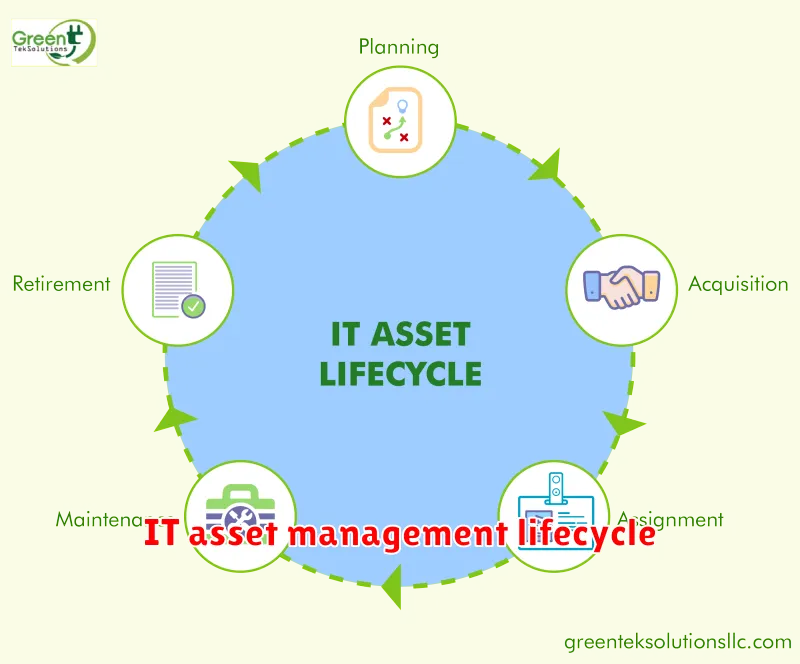Are you struggling to keep track of your company’s ever-growing inventory of IT assets? From laptops and smartphones to servers and software licenses, managing these assets can be a daunting task. In today’s fast-paced business environment, efficient IT asset management is no longer a luxury, but a necessity. An effective IT asset management tool can streamline your operations, optimize costs, and ultimately boost your bottom line.
This comprehensive guide will explore the benefits of IT asset management, delve into the essential features of powerful tools, and provide insights on choosing the best solution for your specific business needs. Whether you’re a small startup or a large enterprise, understanding the power of IT asset management tools is crucial for success.
What is IT Asset Management?
IT Asset Management (ITAM) is a strategic process that involves identifying, tracking, and managing all IT assets throughout their lifecycle. These assets can include anything from physical hardware like computers, servers, and printers to software, licenses, and cloud services.
The core goal of ITAM is to maximize the value of IT assets while minimizing risks and costs. This involves activities such as:
- Asset Discovery: Identifying all IT assets within an organization.
- Asset Inventory: Creating a detailed record of each asset, including its specifications, location, and ownership.
- Asset Tracking: Monitoring asset movement, usage, and status throughout their lifecycle.
- Asset Management: Implementing policies and procedures for acquiring, deploying, maintaining, and disposing of assets.
- Asset Optimization: Utilizing assets effectively and efficiently to maximize their value.
By implementing an effective ITAM strategy, organizations can gain a number of benefits, including:
- Reduced Costs: Optimizing asset utilization, reducing redundant purchases, and avoiding unnecessary software licenses.
- Improved Security: Identifying and managing vulnerabilities associated with outdated or unpatched assets.
- Enhanced Compliance: Ensuring adherence to regulatory and legal requirements related to data privacy and security.
- Increased Efficiency: Streamlining asset deployment and management processes for better service delivery.
ITAM is essential for modern businesses looking to optimize their IT investments and ensure efficient, secure, and compliant operations.
Benefits of Using IT Asset Management Tools
In today’s digital age, businesses heavily rely on IT assets to operate efficiently. From computers and servers to software licenses and network infrastructure, these assets play a vital role in supporting daily operations. To ensure optimal performance, security, and cost-effectiveness, implementing a robust IT asset management (ITAM) strategy is crucial.
ITAM tools offer numerous benefits, including:
-
Improved Asset Visibility and Control
ITAM tools provide a centralized repository for tracking all your IT assets, giving you a comprehensive view of what you own, where it’s located, and its current status. This enhanced visibility enables you to make informed decisions about asset utilization, optimize resource allocation, and minimize waste.
-
Enhanced Security and Compliance
By maintaining an accurate inventory of your IT assets, you can identify and address security vulnerabilities more effectively. ITAM tools can help you enforce security policies, manage access controls, and ensure compliance with industry regulations like GDPR and HIPAA.
-
Cost Optimization and Savings
ITAM tools empower you to streamline asset procurement, reduce redundant purchases, and negotiate better deals with vendors. By identifying underutilized assets, you can optimize resource allocation and minimize unnecessary expenses. Additionally, tracking software licenses helps you avoid costly licensing violations and ensure compliance.
-
Increased Productivity and Efficiency
With ITAM tools, employees can easily access the resources they need, minimizing downtime and improving overall productivity. By automating asset management tasks, you free up IT staff to focus on strategic initiatives and provide better support to end users.
-
Improved Decision-Making
ITAM tools provide real-time data and insights into your IT environment, enabling you to make data-driven decisions regarding asset acquisition, deployment, and disposal. This data can help you identify areas for improvement, optimize resource allocation, and plan for future IT investments.
In conclusion, implementing an ITAM strategy with the right tools can significantly improve your business operations by enhancing asset visibility, security, cost efficiency, productivity, and decision-making. By leveraging the benefits of ITAM, you can gain a competitive edge, optimize your IT investments, and achieve your business goals.
Key Features of IT Asset Management Tools
IT asset management tools play a crucial role in streamlining business operations by providing a centralized platform for managing all your IT assets. These tools offer a range of features to ensure optimal utilization, security, and compliance. Here are some key features you should look for in an IT asset management tool:
1. Asset Discovery and Inventory: A comprehensive IT asset management tool should automatically discover and track all your assets, including hardware, software, and licenses. This feature helps you maintain an accurate and up-to-date inventory, eliminating the need for manual data entry and reducing the risk of missing assets.
2. Asset Tracking and Management: Efficiently tracking your assets is essential for effective management. Look for tools that allow you to track asset location, status (e.g., in use, under repair), and associated information like purchase date, warranty details, and serial numbers.
3. Software License Management: Managing software licenses can be complex and challenging. A good IT asset management tool should automate license management, tracking usage, ensuring compliance, and reducing the risk of overspending on software.
4. Reporting and Analytics: Detailed reporting and analytics are critical for understanding your IT asset landscape and making informed decisions. Look for tools that provide customizable reports, dashboards, and insights into asset utilization, cost, and risk.
5. Integration with Other Systems: Integration with other systems like help desks, procurement systems, and cloud services is essential for seamless operations. Ensure the tool can easily integrate with your existing infrastructure, reducing data redundancy and improving data accuracy.
6. Security and Compliance: Security and compliance are paramount in IT asset management. Choose a tool that offers features like access control, data encryption, and auditing capabilities to protect sensitive data and ensure compliance with industry regulations.
7. Asset Lifecycle Management: Effective IT asset management goes beyond simply tracking assets. Look for tools that support the entire asset lifecycle, from procurement to disposal, ensuring responsible asset management practices.
By leveraging IT asset management tools with these key features, you can optimize your IT operations, reduce costs, improve efficiency, and ensure compliance with regulatory requirements. The right tool will empower you to make data-driven decisions and streamline your business operations for greater success.
Choosing the Right IT Asset Management Tool for Your Business
In today’s digital age, businesses rely heavily on technology, making IT asset management a crucial aspect of operations. Effectively managing your IT assets can streamline workflows, optimize costs, and ensure regulatory compliance. However, with a multitude of IT asset management tools available, selecting the right one for your business can seem overwhelming.
To ensure you choose the best fit, consider these key factors:
- Scalability: The tool should accommodate your current needs while scaling as your business grows.
- Features: Look for functionalities such as asset discovery, inventory management, software licensing, and reporting.
- Integration: The tool should seamlessly integrate with your existing systems and applications.
- User-friendliness: The interface should be intuitive and accessible to your IT staff.
- Budget: Determine your budget and select a tool that offers a reasonable price point.
- Security: Data security is paramount. Choose a tool with strong security measures to protect sensitive information.
- Vendor support: Reliable vendor support is crucial for troubleshooting and ongoing assistance.
Once you have a clear understanding of your business requirements, you can evaluate different IT asset management tools. Some popular options include:
- ServiceNow
- Ivanti
- ManageEngine
- SolarWinds
By carefully considering these factors and researching available solutions, you can choose the right IT asset management tool to streamline your business operations and maximize the value of your technology investments.
Top IT Asset Management Tools in the Market
Effective IT asset management is crucial for any organization seeking to streamline its operations, optimize resource utilization, and minimize potential risks. Thankfully, a plethora of robust IT asset management tools exist to assist businesses in achieving these goals. This article will delve into some of the leading IT asset management tools available in the market, highlighting their key features and benefits.
Top IT Asset Management Tools
Here are some of the top IT asset management tools in the market:
- ManageEngine ServiceDesk Plus: A comprehensive IT service management (ITSM) solution that includes robust IT asset management capabilities. It offers features such as asset discovery, inventory management, software license tracking, and reporting, enabling organizations to gain a comprehensive view of their IT assets.
- SolarWinds Asset Management: A powerful tool designed specifically for IT asset management. It provides automated discovery, comprehensive inventory management, software license compliance tracking, and reporting, empowering organizations to effectively manage their IT assets throughout their lifecycle.
- Microsoft Azure Asset Management: A cloud-based solution integrated with Microsoft Azure. It offers centralized asset tracking, automated discovery, and reporting capabilities, providing businesses with a scalable and secure platform for managing their IT assets.
- IBM Maximo Asset Management: A comprehensive enterprise asset management (EAM) solution that encompasses IT asset management capabilities. It provides advanced features for asset tracking, maintenance scheduling, and performance monitoring, enabling organizations to optimize the utilization and lifespan of their IT assets.
- Freshservice: An ITSM platform that incorporates strong IT asset management functionality. It offers features like asset discovery, inventory management, software license tracking, and reporting, assisting organizations in managing their IT assets efficiently.
Choosing the right IT asset management tool depends on your specific requirements and budget. By carefully evaluating these tools and considering your organization’s unique needs, you can select the best solution to streamline your IT operations and achieve greater efficiency.
Implementing IT Asset Management Tools in Your Organization
In today’s digital landscape, businesses rely heavily on technology, and managing their IT assets effectively is crucial for optimizing operations, minimizing costs, and ensuring security. Implementing robust IT asset management tools can significantly improve efficiency and visibility, enabling organizations to make informed decisions about their IT infrastructure. This guide provides a comprehensive overview of how to successfully implement these tools in your organization.
1. Define Your IT Asset Management Goals: Before embarking on the implementation process, clearly define your IT asset management goals. What are you hoping to achieve? Do you want to improve inventory tracking, streamline procurement, enhance security, or optimize software licensing? Having well-defined goals will provide direction and ensure that the tools you choose align with your organizational objectives.
2. Conduct a Thorough Assessment: A thorough assessment of your existing IT infrastructure is essential. Identify all your current IT assets, including hardware, software, and licenses. This assessment will help you understand your current situation, identify any gaps, and determine the requirements for your IT asset management tools.
3. Choose the Right Tools: A wide range of IT asset management tools are available, each with its unique features and capabilities. Consider factors such as your budget, the size of your organization, and your specific needs when making a selection. Some popular options include:
- Cloud-based solutions provide scalability and flexibility.
- On-premises solutions offer greater control and customization.
- Hybrid solutions combine the benefits of both.
4. Implementation and Training: Once you’ve chosen your IT asset management tools, ensure a smooth implementation process. Provide adequate training to your IT staff and end-users to maximize tool adoption and ensure they can use the system effectively. Regular training and ongoing support are crucial for long-term success.
5. Integrate with Existing Systems: To avoid creating silos of data, integrate your IT asset management tools with other existing systems, such as your help desk, procurement, and financial systems. This integration will provide a holistic view of your IT assets and streamline workflows.
6. Monitor and Optimize: Regularly monitor your IT asset management system to ensure its effectiveness. Track key performance indicators (KPIs) and identify areas for improvement. Continuous optimization is essential for maximizing the value of your IT asset management investment.
By implementing IT asset management tools, organizations can gain a comprehensive understanding of their IT infrastructure, optimize resource allocation, minimize costs, and enhance security. Following these steps will guide you through a successful implementation process, enabling you to streamline your business operations and achieve your IT asset management goals.
Best Practices for IT Asset Management
Effective IT asset management is crucial for any organization seeking to streamline its business operations, optimize resource allocation, and minimize IT-related costs. Implementing a robust IT asset management strategy involves adopting best practices that ensure comprehensive asset tracking, efficient lifecycle management, and adherence to industry regulations.
1. Establish a Comprehensive Asset Inventory: A comprehensive asset inventory serves as the foundation for effective IT asset management. This inventory should include detailed information about each asset, such as its name, serial number, model, purchase date, warranty details, location, and assigned user. Utilizing a dedicated IT asset management tool can simplify the process of data collection and ensure accuracy.
2. Implement a Standardized Asset Naming Convention: Consistent and logical asset naming conventions enhance organization and facilitate easy identification. A standardized naming system helps reduce confusion and improves search capabilities.
3. Leverage Automation: Automate repetitive tasks such as asset discovery, software updates, and license management to save time and minimize manual errors. Automated tools can scan your network for new assets, track software usage, and ensure compliance with software licensing agreements.
4. Integrate with Other Systems: Integrate your IT asset management system with other business systems, such as procurement, help desk, and financial management, to streamline workflows and create a holistic view of asset data.
5. Implement Regular Audits: Conduct regular audits to verify the accuracy of your asset inventory, identify discrepancies, and ensure that assets are being utilized effectively.
6. Establish Clear Policies and Procedures: Establish clear policies and procedures for asset acquisition, deployment, utilization, disposal, and security. These policies should align with industry best practices and regulatory requirements.
7. Promote Asset Management Awareness: Train employees on the importance of IT asset management and their role in adhering to established policies. Encourage users to report asset issues promptly and to follow proper asset disposal procedures.
By implementing these best practices, organizations can achieve greater visibility into their IT assets, optimize resource utilization, reduce costs, and improve overall IT service delivery. Effective IT asset management empowers businesses to make informed decisions, mitigate risks, and drive operational efficiency.
Measuring the ROI of IT Asset Management
IT asset management (ITAM) is a crucial aspect of any organization’s success. By implementing effective ITAM practices, companies can optimize their IT infrastructure, reduce costs, and enhance productivity. But how can you quantify the benefits of ITAM and demonstrate its return on investment (ROI)?
Measuring the ROI of ITAM can be challenging, but it’s essential for justifying investments and showcasing the value of ITAM to stakeholders. Here are some key metrics to track:
Key Metrics for Measuring ITAM ROI
- Reduced hardware and software costs: ITAM helps identify underutilized or redundant assets, leading to cost savings through consolidation or disposal. It can also prevent unnecessary purchases by ensuring accurate inventory and licensing.
- Improved asset utilization: ITAM tracks asset usage, allowing organizations to optimize resource allocation and ensure that assets are deployed efficiently.
- Enhanced security and compliance: ITAM plays a vital role in managing security risks by providing visibility into all IT assets and ensuring compliance with relevant regulations.
- Reduced downtime: By tracking asset lifecycles and maintenance schedules, ITAM minimizes downtime and ensures that critical systems remain operational.
- Increased productivity: ITAM helps streamline IT processes, reducing time spent on manual tasks and freeing up IT staff to focus on strategic initiatives.
By tracking these metrics and analyzing the impact of ITAM on key business operations, organizations can demonstrate the tangible benefits of ITAM and justify further investments in ITAM tools and processes.
Future Trends in IT Asset Management
IT asset management is rapidly evolving, driven by technological advancements, changing business needs, and the growing importance of data security and compliance. As we look ahead, several key trends will shape the future of IT asset management.
Cloud-based ITAM: The rise of cloud computing is transforming how businesses manage their IT assets. Cloud-based ITAM solutions offer several advantages, including scalability, accessibility, and cost-effectiveness. These solutions can help organizations centralize asset data, automate processes, and gain real-time insights into their IT infrastructure.
Artificial Intelligence (AI) and Machine Learning (ML): AI and ML are increasingly being used to automate tasks, improve data analysis, and provide predictive insights in IT asset management. AI-powered tools can help organizations identify and address potential issues before they arise, optimize asset utilization, and automate asset lifecycle management.
Internet of Things (IoT) Integration: The proliferation of IoT devices is adding complexity to IT asset management. ITAM solutions need to be able to manage and track these devices effectively, ensuring their security, performance, and compliance.
Data Security and Compliance: Data security and compliance are paramount in IT asset management. Organizations must ensure that their IT assets are protected from unauthorized access, data breaches, and cyberattacks. Emerging regulations like GDPR and CCPA will continue to influence ITAM best practices.
Sustainability and Green IT: As organizations become more environmentally conscious, sustainable IT asset management is gaining importance. Companies are seeking ways to reduce their carbon footprint and minimize e-waste. ITAM solutions can play a crucial role in tracking asset lifecycles, promoting responsible disposal, and enabling organizations to make informed decisions about asset procurement and upgrades.
By embracing these future trends, organizations can streamline their IT asset management processes, optimize asset utilization, improve data security, and drive business growth.
IT Asset Management for Small Businesses
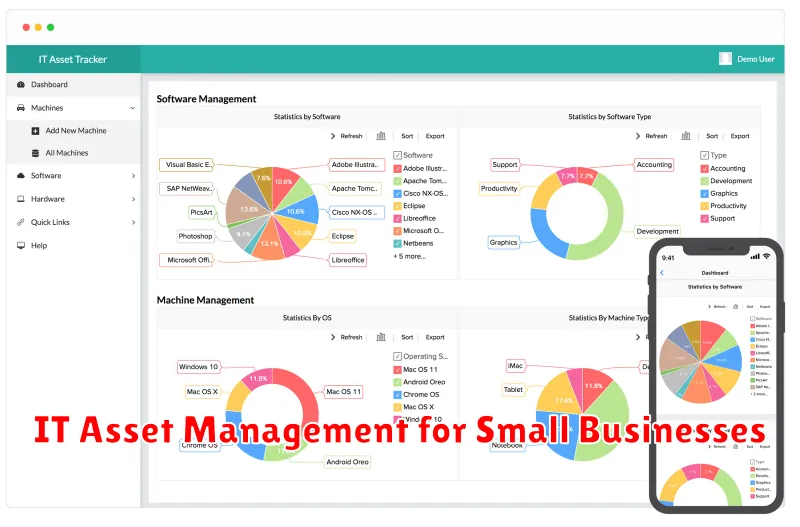
IT asset management (ITAM) is often seen as a complex process best suited for large enterprises. However, for small businesses, implementing a robust ITAM strategy can be equally valuable and even more manageable. By taking control of your IT assets, you can streamline operations, optimize costs, and minimize security risks.
Here’s why ITAM is crucial for small businesses:
- Cost optimization: ITAM helps you track software licenses, hardware inventory, and maintenance contracts, preventing unnecessary spending on duplicate software or outdated equipment.
- Improved security: Managing assets ensures that only authorized individuals have access to sensitive data, reducing the risk of unauthorized access or data breaches.
- Enhanced productivity: By identifying and addressing IT issues proactively, you can minimize downtime and ensure employees have the tools they need to be productive.
- Compliance: ITAM helps small businesses comply with legal requirements and industry regulations regarding data security and software licensing.
Fortunately, implementing ITAM for small businesses doesn’t require a massive investment in complex software. Several affordable and user-friendly ITAM tools are available, designed specifically for smaller businesses. These tools can help you manage assets, track software licenses, and automate tasks, making the process efficient and accessible.
By adopting a comprehensive ITAM approach, small businesses can reap significant benefits, improving efficiency, reducing costs, and strengthening their overall IT posture. It’s a valuable investment that can help small businesses thrive in today’s competitive landscape.
IT Asset Management for Enterprises
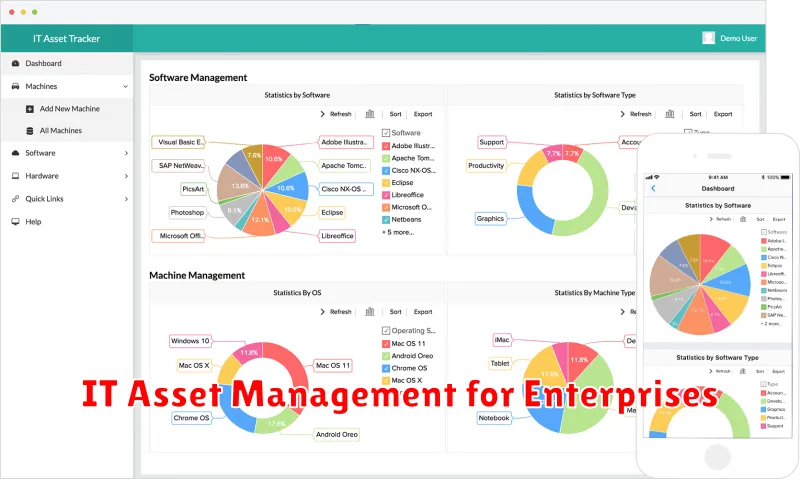
In today’s digital landscape, businesses are increasingly reliant on technology to drive efficiency, productivity, and innovation. However, managing a vast inventory of IT assets can be a daunting task, fraught with challenges such as tracking, security, and compliance. This is where IT Asset Management (ITAM) comes into play.
IT Asset Management for enterprises involves the comprehensive management of an organization’s IT assets throughout their lifecycle. It encompasses processes for tracking, controlling, and optimizing the use of hardware, software, licenses, and other IT resources. By implementing a robust ITAM strategy, enterprises can reap numerous benefits, including:
- Cost Reduction: ITAM helps identify and eliminate unnecessary spending on underutilized assets, optimize licensing costs, and reduce hardware and software acquisition costs.
- Enhanced Security: By tracking all IT assets, organizations can ensure proper security measures are in place, mitigate risks, and comply with industry regulations.
- Improved Efficiency: ITAM streamlines asset management processes, enabling faster deployment, maintenance, and disposal of assets, leading to improved operational efficiency.
- Increased Productivity: Optimized asset utilization and streamlined workflows contribute to a more productive and agile workforce.
- Enhanced Compliance: ITAM helps organizations comply with various industry regulations and standards, such as GDPR and HIPAA, by ensuring proper asset management practices.
There are various tools available to support enterprise-level ITAM, each with its unique features and capabilities. These tools can automate asset discovery, tracking, and reporting, providing comprehensive visibility into the organization’s IT landscape. Some of the key features of ITAM tools include:
- Asset Discovery: Identifying and cataloging all IT assets within the organization’s network.
- Asset Tracking: Maintaining a centralized repository of asset information, including hardware specifications, software licenses, and maintenance agreements.
- License Management: Tracking software licenses, ensuring compliance, and optimizing license usage.
- Asset Deployment and Retirement: Managing the lifecycle of assets, from deployment to decommissioning.
- Reporting and Analytics: Generating reports and dashboards to provide insights into asset utilization, cost, and compliance.
IT Asset Management is crucial for modern enterprises seeking to optimize their IT operations, reduce costs, enhance security, and improve compliance. By leveraging the right tools and implementing a comprehensive ITAM strategy, businesses can gain a competitive edge in today’s digital world.
IT Asset Management in the Cloud
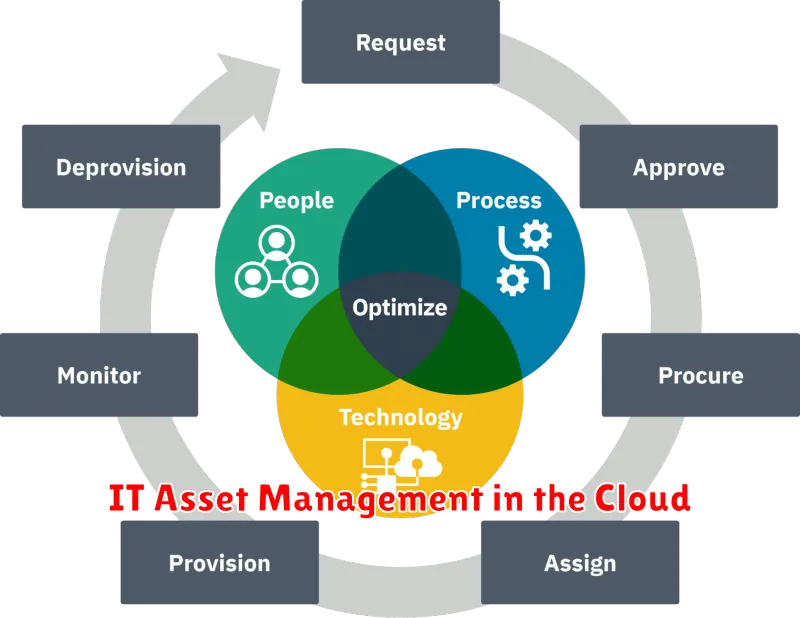
IT asset management is crucial for businesses of all sizes. It helps you track, manage, and optimize your technology investments, ensuring they’re always working for you. In today’s digital world, moving your IT asset management to the cloud offers numerous advantages, making it a strategic move for streamlining your business operations.
Cloud-based IT asset management tools offer a centralized platform for managing all your IT assets, from hardware and software to licenses and contracts. This simplifies your inventory management, allowing you to quickly identify and track all your assets across your entire organization. With a clear overview of your assets, you can make informed decisions about procurement, deployment, and disposal, optimizing your IT infrastructure and minimizing waste.
Cloud solutions provide seamless integration with other business systems, such as your ERP or CRM. This integration allows you to streamline your workflows and automate tasks like asset provisioning, license management, and even financial reporting. By automating these tasks, you free up your IT team to focus on more strategic initiatives, driving innovation and improving overall business efficiency.
Scalability is a key benefit of cloud-based IT asset management. As your business grows, your IT needs will evolve. Cloud solutions offer the flexibility to scale your asset management capabilities on demand, accommodating your changing requirements without the need for costly hardware upgrades. This scalability ensures your IT infrastructure can support your future growth while keeping your costs in check.
The cloud provides increased security for your IT assets. With robust security measures built into the platform, your data is protected from unauthorized access and cyber threats. This ensures compliance with regulations, such as GDPR, and protects your business from data breaches and financial losses.
Adopting cloud-based IT asset management tools is a smart move for any business looking to streamline their operations. It offers a centralized platform for managing all your IT assets, improves efficiency, enhances security, and provides the scalability to adapt to your evolving business needs. By embracing the cloud, you can optimize your IT investments and gain a competitive edge in today’s digital landscape.
IT Asset Management and Cybersecurity
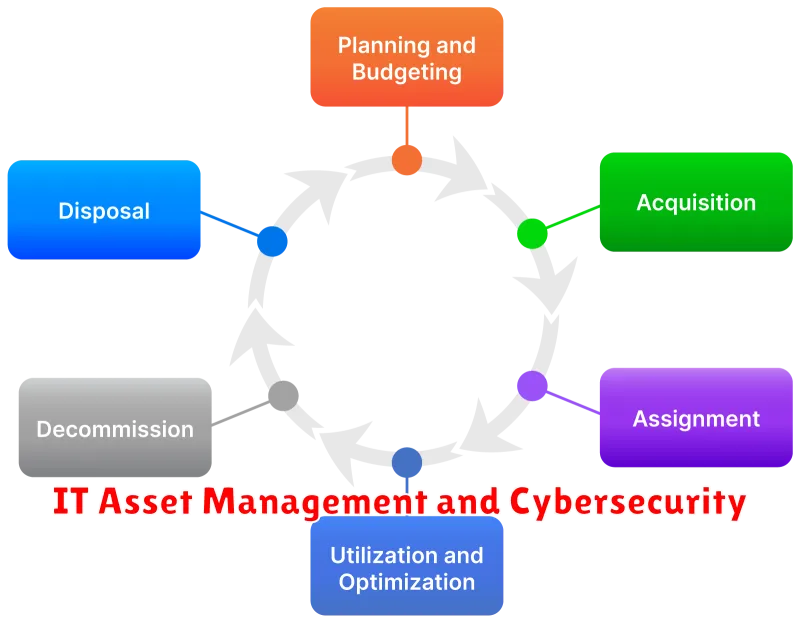
In today’s digital landscape, where businesses rely heavily on technology, managing IT assets effectively is crucial for both operational efficiency and cybersecurity. IT asset management (ITAM) involves the comprehensive tracking and control of all technology assets, from hardware and software to cloud services and licenses. A robust ITAM strategy not only streamlines business operations but also strengthens cybersecurity posture by mitigating risks and vulnerabilities.
One of the key benefits of ITAM is improved asset visibility. By accurately identifying and documenting all IT assets, businesses gain a clear understanding of their inventory, allowing them to optimize resource allocation, prevent unnecessary spending, and ensure compliance with licensing agreements. This visibility also plays a critical role in cybersecurity, as it enables organizations to identify and address potential security weaknesses, such as outdated software or unauthorized devices.
Another crucial aspect of ITAM is risk management. By continuously monitoring assets and their vulnerabilities, businesses can proactively mitigate security threats. This includes identifying and patching software vulnerabilities, implementing access controls, and ensuring data backups are regularly performed. A comprehensive ITAM strategy helps organizations stay ahead of cyberattacks and reduce the risk of data breaches.
Furthermore, ITAM plays a vital role in compliance. Many industry regulations, such as HIPAA and PCI DSS, require organizations to maintain accurate records of their IT assets. A robust ITAM solution ensures compliance with these regulations, minimizing the risk of fines and penalties. By streamlining asset management processes, businesses can demonstrate their commitment to data privacy and security.
In conclusion, ITAM is an essential component of any comprehensive cybersecurity strategy. By improving asset visibility, managing risks, and ensuring compliance, ITAM empowers organizations to protect their valuable assets and maintain a secure digital environment. Implementing a robust ITAM solution can streamline business operations, enhance cybersecurity, and foster long-term success.
The Role of Automation in IT Asset Management
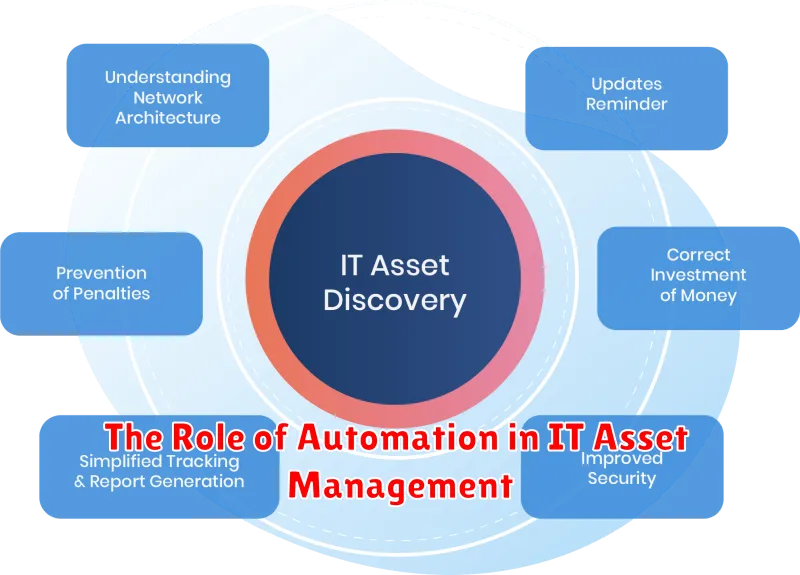
In the dynamic landscape of modern businesses, efficient IT asset management is no longer a mere option but a necessity. The sheer volume and complexity of IT assets, ranging from hardware and software to licenses and subscriptions, necessitate a robust and streamlined approach. This is where automation emerges as a game-changer, revolutionizing the way organizations manage their IT assets.
Automation empowers IT asset management by eliminating manual processes that are prone to errors and inefficiencies. It automates tasks such as asset discovery, inventory management, software license tracking, and asset lifecycle management. By automating these processes, organizations can achieve significant gains in terms of accuracy, efficiency, and cost savings.
One of the key benefits of automation in IT asset management is real-time visibility. Automated systems can continuously monitor and track assets, providing up-to-the-minute data on their status, location, and usage. This real-time visibility enables organizations to make informed decisions regarding asset procurement, deployment, and retirement.
Moreover, automation facilitates proactive asset management. By analyzing asset data and identifying potential issues, automated systems can trigger alerts and notifications, enabling organizations to address problems before they escalate. This proactive approach helps prevent downtime, reduce maintenance costs, and ensure business continuity.
In conclusion, automation plays a pivotal role in IT asset management, enabling organizations to streamline their operations, improve efficiency, and optimize asset utilization. By leveraging automation tools, businesses can gain valuable insights into their IT assets, make data-driven decisions, and ultimately achieve their business objectives.

